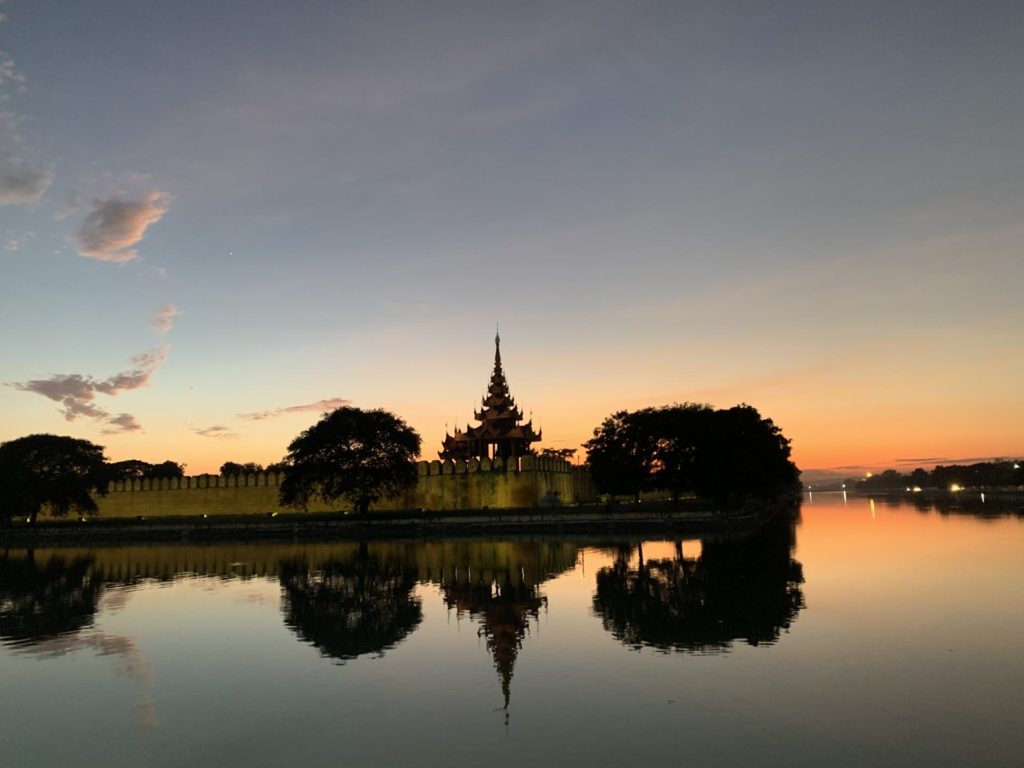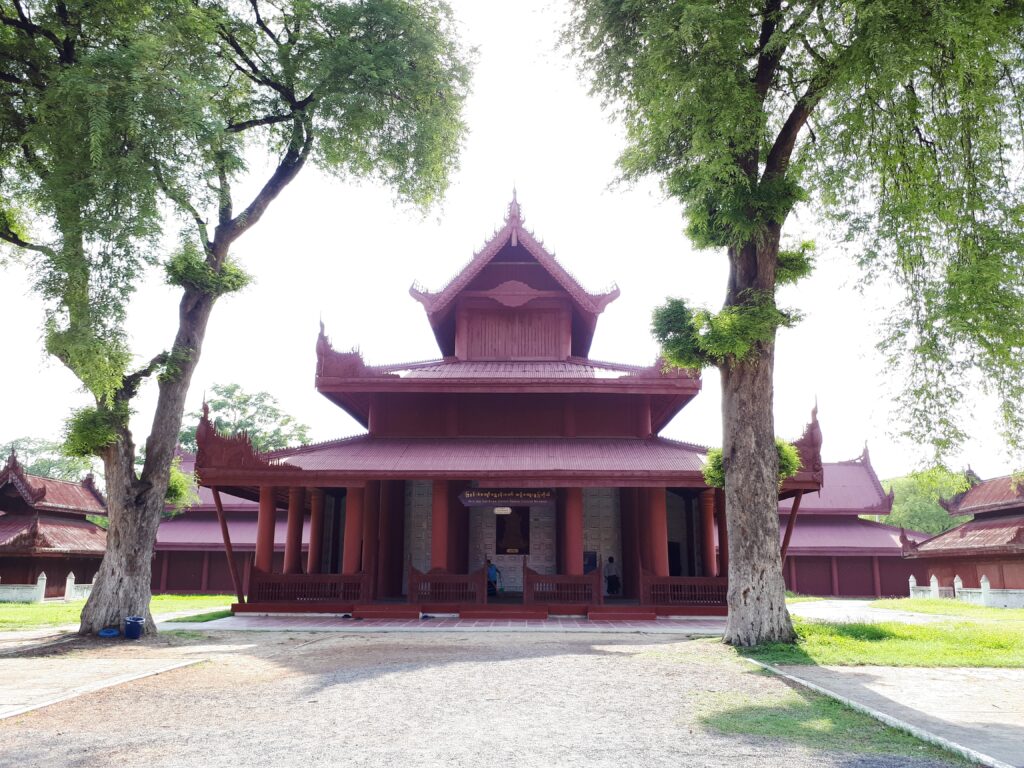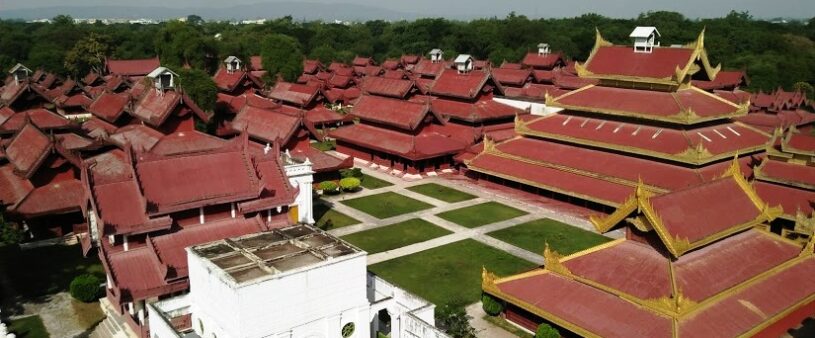The year was 1885 and the last Burmese king was standing strong. The British forces were marching into Mandalay with very little opposition. Their plan to take over the country was succeeding- but capturing the Royal Palace of Mandalay in the centre of the city, was going to be an important symbolic victory.
As it turned out, overtaking the palace- and King ThibawMin- was even easier than predicted. The British demanded unconditional surrender and that’s what they got.The King and Queen were put on a bullock cart and taken down to the river to be sent into exile in India.
The story goes that when the British soldiers pulled out their guns, the King dropped down to his knees and begged for his life to be spared. His queen, however, walked on her own defiantly towards the steamer on the mighty Irrawaddy.
After the British invasion, the palace was used by the colonialists as a base for troops in Mandalay and many of the royal treasures were looted and sent back to London ( many are still on display at the Victoria and Albert Museum).
Every global aggress or eventually must face a rising challenger. And so it was that during the Second World War, Japanese forces captured he Mandalay Palace and used it as a supply depot for their expansions in the region. In retaliation, the Allies bombed the compound and most of it was burnt to the ground.
Only one major wooden building survived-the Shwenandaw Monastery, which is built completely of teak and is decorated throughout with detailed and ornate carvings. The watch tower and royal mint were also undamaged. The rest of the Royal Palace has been rebuilt from scratch.
So, almost everything you walk through from the entrance hall all the way past the throne room and to the residences was constructed in the early 1990’s. Although it is faithful to the original design and some traditional construction techniques were used, modern materials like concrete and corrugated iron were incorporated into the reconstructions.
Visiting the palace is one of the best things to do in Mandalay. It doesn’t take too long to walk through the palace but it can take a long time to get into it. The palace grounds are massive and dominate the cityscape. They are huge square of about two kilometers on each side, surrounded by a 64 meter-wide moat. Only one entrance can be used by tourists-the eastern- and it can take a long time to get to it if you happen to be on the other side (where most of the hotels are).

There are some great tours in Mandalay, many of which include the Royal Palace. Have a look at these ones that I would recommend:
The reason for the inconvenience is because the actual restored palace takes up only a small space in the centre of the grounds. The rest of the area is used now as a military base and big signs (and guards) remind you that it’s a restricted zone.
At least it is back in the hands of the local people again, whatever the international view of the Myanmar military is.
After the British control and then the Japanese it seems there is now plenty of protection for this important symbol of Mandalay and Myanmar. Nobody will march unopposed through these gates again.
” The last Palace built by Burmese Royals”
When King Mindon Min founded Mandalay in 1857 he ordered construction of a new Royal Palace called the “Mya Nan San Kyaw”. The old Royal Palace in the former capital Amarapura was dismantled, transported to Mandalay and rebuilt there.
The Mandalay Royal Palace is the last Palace built by Burmese Royals. On the large complex are dozens of buildings including audience halls, throne halls, a monastery, a watch tower, a court building, a tooth relic building and a library where the Buddhist scriptures were kept.
“The citadel with the teak wood Palace”
The Palace that was completely made from teak wood was built in the center of a large citadel or fort. The square citadel was surrounded by four walls each 2 kilometers long with a total of 48 turrets. In the walls were 12 gates, one for each sign of the Zodiac. Around the walls was a 60 meter wide moat, crossed by a number of bridges.
“Watch Tower”
The watch tower is a very solid reddish brown cylindrical tower measuring 24 meters high. It is topped by a golden seven tiered Pyatthat roof. The stairway winding around the tower can be climbed, which gives a good overview of the Palace and great views of Mandalay.
The watch tower is one of only two original buildings left, the other one being the Royal Mint.
” Tooth relic Tower”
Close to the main entrance is the Burmese style tooth relic tower. The all white square structure has a small square relic chamber on top and a steep stairway leading to it. In spite of its name the building never contained a relic from the Buddha, it houses a Buddha statue instead.
“Supreme Court Building”
A number of Royal Mausoleums was erected for the remains of several members of the Burmese Royal Family. One if for the founder of Mandalay and the Royal Palace, King Mindon Min.
“Great Audience Hall”
The Great Audience Hall is another very attractive, intricately decorated building. The hall is about 75 meters long and topped with a seven tiered Pyatthat roof. In front of it are a few old canons. The wooden bargeboards and eaves boards on the roof are all carved in flower patterns. In the original building there were also gilded.
“Lion Throne Room”
The Lion Throne room contained the Lion Throne, an extremely richly decorated and ornamented wooden throne. In total there were eight thrones in the Palace, of which the Lion Throne was the most important.
On top of the Lion Throne room is a seven tiered Pyatthat roof, richly decorated and gold plated. This Pyatthat marks the center of the Palace.
“Glass Palace”
The Glass Palace is one of the largest and most beautiful structures of the Palace. This building was used as Kin Mindon’s personal living quarters. It contains two large rooms, one of which contained the Bee Throne, the other one was separated into a number of smaller rooms, which were the King’s living room and bed room , as well as a number of rooms for his Queens.
“Golden Palace Monastery”
The Shwenandaw Kyaung or Golden Palace Monastery is a very ornate teak building that was originally contained in the Palace compound. It was later moved to its current location just outside the Palace grounds and converted into a Buddhist monastery. The Golden Palace Monastery is the only major all teak building that remains of the original Royal Palace.
It has been a century since the last King of Burmese staying in the Royal Mandalay Palace. To date, it has been restored several times and become one of the most popular attractions to visit in Myanmar tours. Once witnessing the charm of the fabulous architecture and learn more about its history, it ensures to deliver you an interesting experience in the Golden Land of Myanmar.








